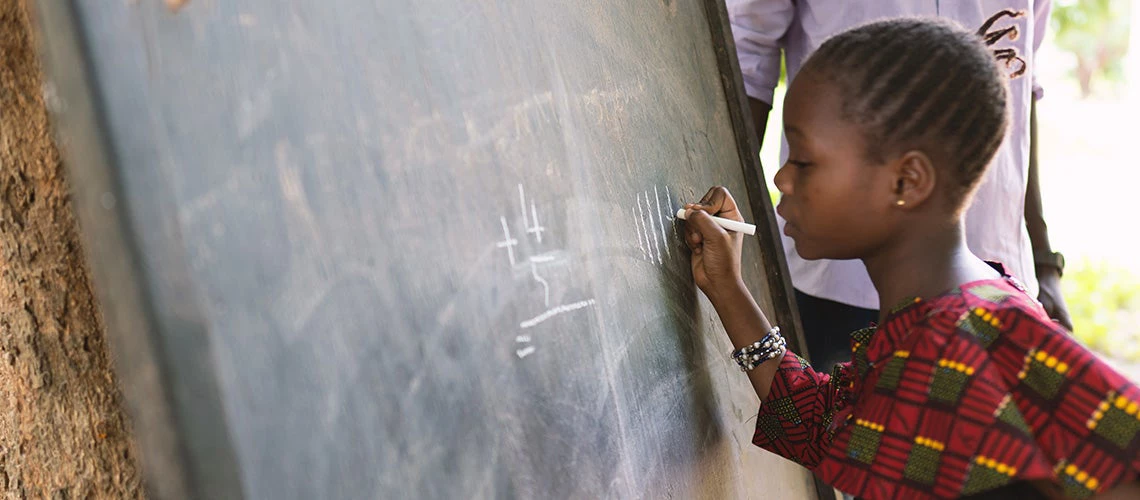 A girl is writing numbers on a blackboard during open air classes in a rural community in West Africa. | © shutterstock.com
A girl is writing numbers on a blackboard during open air classes in a rural community in West Africa. | © shutterstock.com
Five years ago, World Development Report 2018 Learning to Realize Education’s Promise (WDR 2018), highlighted a global learning crisis and emphasized the need to enhance teacher effectiveness as a solution. The report provided a roadmap for improvement, but have countries successfully addressed the crisis? The answer is complex, and progress has been slow. In this blog, we delve into some of the challenges of transforming teacher effectiveness.
The significance of teachers is a common thread in inspiring stories, movies, and personal narratives. Esau McCaulley's essay, “What Mrs. Bailey Taught Me in A.P. History Changed My Life”, painfully illustrates the profound influence teachers have on young people.
We also see this in empirical research, which has offered remarkable insights into the pivotal role of teachers. For example, we’ve learned that if a student can move from having a low-performing to a high-performing teacher, the learning gains can be equivalent to multiple years of business-as-usual schooling. (See also research from the US, Uganda, and Pakistan on this.)
When one asks what specific attributes make teachers effective, evidence becomes elusive.
The traditional metrics that drive teacher selection - qualifications, experience, test scores, training, and professional development – have proven to be weak predictors of a teacher’s ability to enhance student learning. In Pakistan, while effective teachers increase learning substantially, observed teacher characteristics account for less than 5 percent of the variation in teacher effectiveness.
How to solve the puzzle? Teachers are crucial, but identifying the exact qualities that matter is challenging.
Intuitively, we recognize factors such as attendance and engagement. The WDR 2018 revealed that in public schools across six countries, approximately 20 percent of teachers were absent on a typical school day, on average. Furthermore, even when present, teachers often did not engage in active instruction. In seven Sub-Saharan countries, students receive only about two and a half hours of teaching a day—less than half the scheduled teaching time (see this paper for more details).
The WDR probed deeper into the contentious issue of teacher absenteeism and effort by consulting teachers themselves. A study encompassing 20,000 teachers across nine developing countries shows that many teachers normalize absenteeism, with nearly one in four considering it acceptable if students were left with work to do. The study also highlighted a dichotomy in teacher attitudes: they acknowledged their responsibility for student learning but felt helpless due to external constraints. Nearly 43 percent believed that “there is little they can do to help a student learn” if parents are uneducated.
Teacher beliefs are a critical piece of the effectiveness puzzle.
Education economists are getting more interested in these beliefs (see here for a recent review). This makes sense. If teachers believe there is nothing wrong with being absent, they are unlikely to respond to interventions designed to make them less absent. If teachers are pessimistic about their ability to teach poor or lagging students, they are unlikely to exert much effort in engaging with these students.
Using machine learning on a large dataset from Tanzania to investigate what precisely about teachers matters, a paper finds that the teachers belief that they can help disadvantaged and struggling students learn matters a LOT. Another recent study shows that teachers in India and Bangladesh believe students know much more than they actually do. In yet another study, teachers’ over-assessment of boys in a specific subject has a positive and significant effect on boys’ achievements and a significant adverse effect on girls. Prior beliefs among teachers can predispose them to evaluate poorer students less favorably than their more affluent classmates, even when their scholastic aptitude and behavior are the same. Teacher beliefs are also being investigated to determine the most effective learning recovery strategies after COVID-related school closures.
What can be done about teacher beliefs? Are they malleable through policy interventions?
Research on this is nascent but promising. A recent study from India revealed that many teachers don’t believe their efforts can improve student learning. However, targeted teacher training that builds resilience and self-efficacy cannot only reshape teachers’ beliefs but also induce them to exert more effort and thereby positively impact student learning.
Ultimately, teachers matter, and their beliefs also matter. Far too many teachers are constrained by self-limiting and pernicious beliefs, particularly the notion that they cannot significantly aid struggling students. It is critically important to develop strategies that help teachers overcome these beliefs, enabling them to support all students in reaching their full potential.
“Children give up on school when their teachers signal to them . . . that they are not smart enough”.
—Abhijit Banerjee and Esther Duflo, Poor Economics (2011), Pg. 271



Join the Conversation